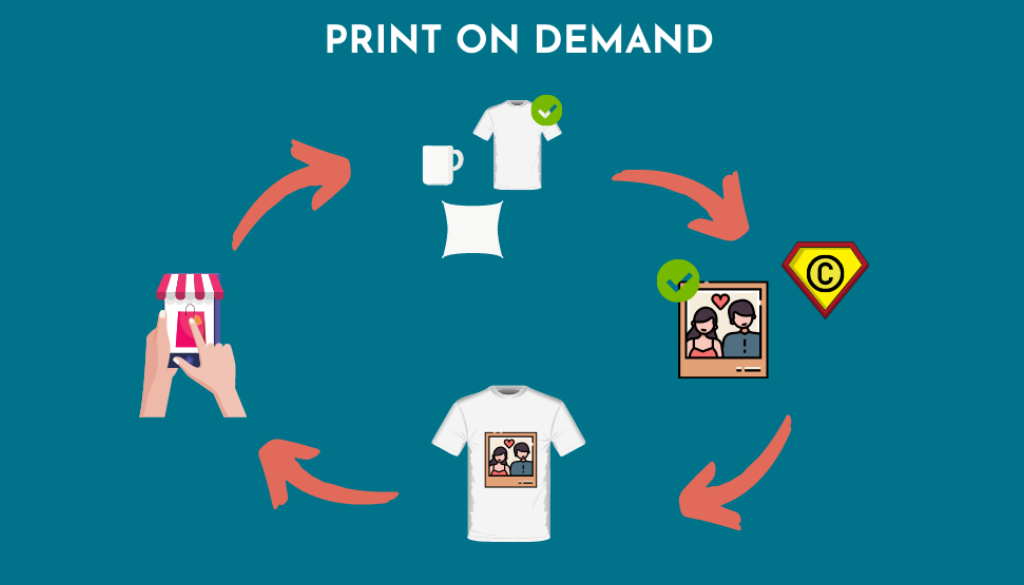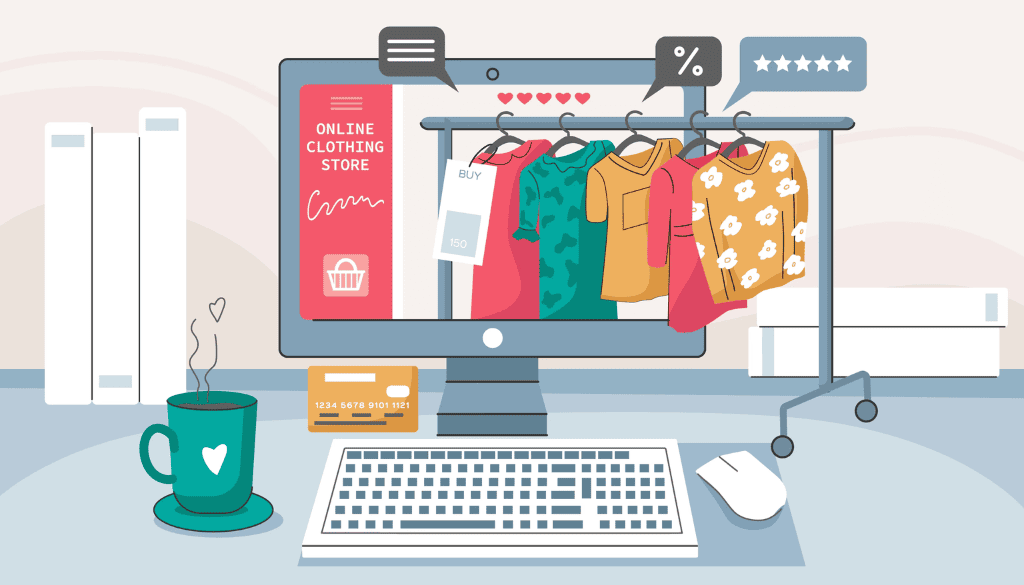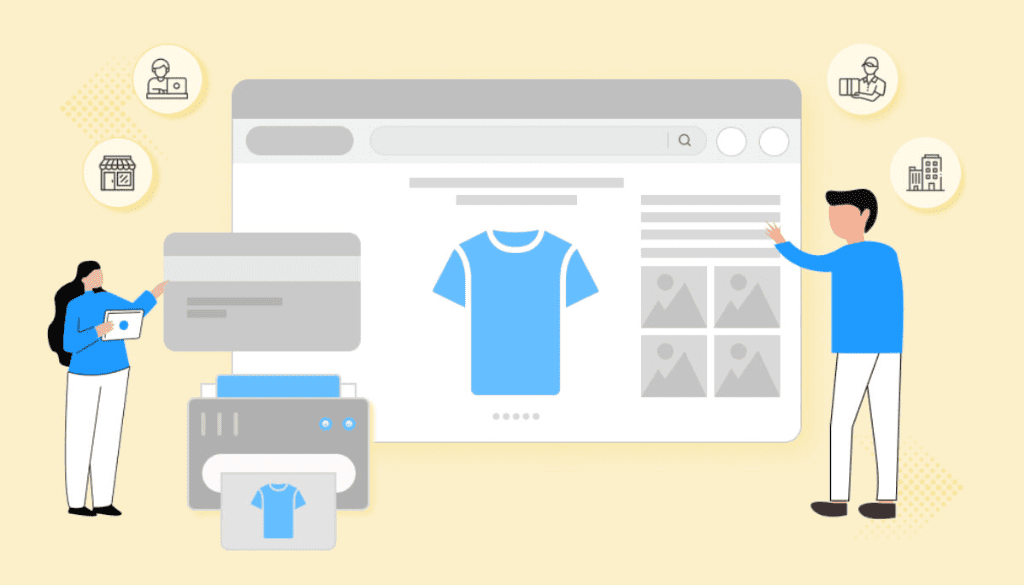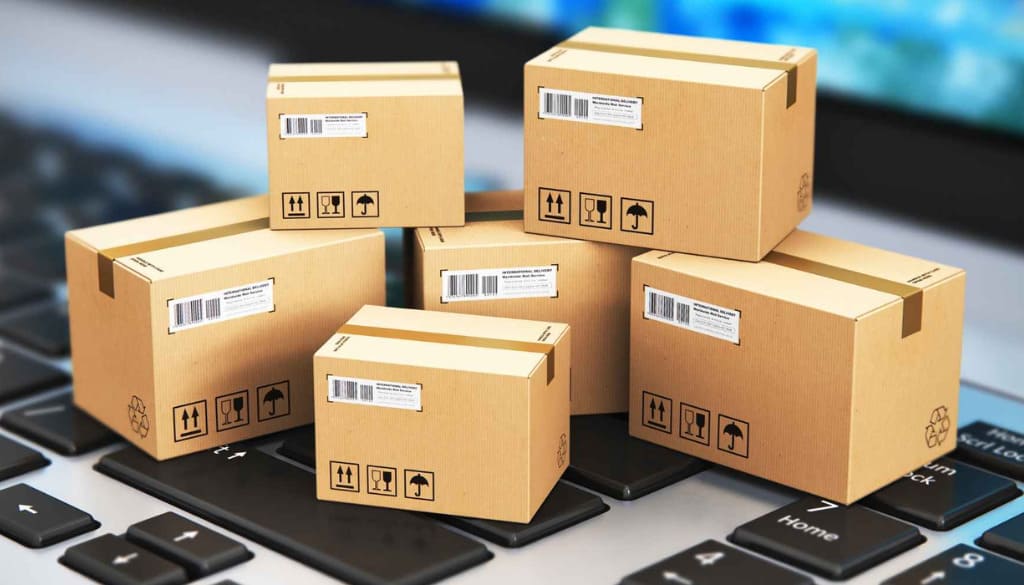The Print on Demand (POD) model is emerging as a prominent business trend in the digital era, thanks to its low startup costs, minimal risks, and the ability to launch quickly without inventory. If you’re looking to start or optimize your POD business, this article will help you understand the essence of the POD model, analyze its pros and cons, explore potential products, examine the operating process, discover sales-support platforms, and learn strategies for sustainable growth. Let FlashShip guide you through building a successful POD brand today.
What is the POD Business Model?
POD – short for Print on Demand – is a modern business model in which products are only printed and produced once an order is placed. Instead of pre-purchasing hundreds of items, storing them, packaging, and handling shipping yourself, the POD model allows sellers to focus on design and marketing, while the entire production fulfillment delivery process is handled by a fulfillment partner.
The core strengths of POD lie in its high customizability, low upfront investment, minimal risk, and scalable nature. In today’s thriving e-commerce landscape, it is an ideal choice for both individual entrepreneurs and businesses aiming to turn creative ideas into branded products.

Advantages and Disadvantages of the POD Model
As with any business model, understanding both its strengths and weaknesses is essential to forming a sound strategy. With Print on Demand – especially when competing on platforms like Amazon, Etsy, or TikTok Shop – this understanding becomes even more critical.
1. Advantages of the POD Model
No Inventory Required – Minimized Financial Risk
- One of the most attractive aspects of POD is that you don’t need to invest in inventory upfront. Instead of tying up capital in stock and worrying about unsold items, sellers only need to create a design and wait for orders. Products are printed only after a real purchase is made, eliminating inventory risks and reducing waste.
Low Startup Costs
- No need for factories, operations staff, or warehouse space. With just a few design ideas and an online store, you can start your POD business journey. It’s an ideal option for new entrepreneurs or sellers wanting to test new products without a high upfront investment.
Easy Design Customization
- Each product in the POD model can carry a unique design tailored to specific target audiences. You can create hundreds of custom t-shirts, tote bags, or mugs with personalized messages without changing your production process. This is especially effective for seasonal campaigns, niche audiences, or short-term trends.
Focus on Branding and Marketing
- With production, packaging, and shipping handled by fulfillment partners like FlashShip, sellers can focus entirely on building their brand, creating content, running ads, and providing customer support. This saves time, boosts business efficiency, and creates a more professional shopping experience.
Scalable Operations – No Order Limits
- As order volume increases, there’s no need to hire more staff or expand your warehouse. The fulfillment system automatically processes new orders – from printing to shipping – ensuring smooth operation and scalability without additional overhead.
2. Disadvantages of the POD Model
Lower Profit Margins Compared to Self-Manufacturing
- Since you’re paying for fulfillment services, production costs in POD are usually higher than if you handled everything in-house. This can reduce profit margins, especially if your pricing isn’t strategic or your advertising costs are not optimized.
Quality Control Depends on the Fulfillment Partner
- Product quality in POD heavily relies on the printing provider. Choosing an unreliable partner may result in print defects, color mismatches, poor fabric quality, or late deliveries – all of which directly impact customer experience and your brand’s reputation.
High Competition – Crowded Market
- POD’s low entry barrier attracts many sellers, leading to fierce competition. To stand out among thousands of similar products, you’ll need to invest in unique designs, creative content, and exceptional customer service.
Order Management and Customer Service
- While production and shipping are outsourced, you are still the one responsible to your customers. You must handle questions, complaints, and any order-related issues – from product quality to fulfillment delays.

Popular Products in POD
One of the most appealing aspects of the POD model is the wide range of product categories available. Choosing the right product that aligns with your target niche and design strengths significantly increases your chances of success. Below are product categories that consistently show high demand:
Apparel
- Unisex T-shirts (Gildan, Bella+Canvas).
- Hoodies, Sweatshirts.
- Tank Tops, Crop Tops.
Accessories
- Tote Bags.
- Baseball Caps.
- Keychains, Stickers, Phone Cases.
Selecting the right product largely depends on the niche market you’re targeting—for example: dog lovers, office workers, gamers, etc.
POD Business Operation Workflow
- To run a Print on Demand (POD) business efficiently and generate consistent profits, sellers must understand the entire process—from design creation to customer service. A well-structured POD system not only saves time but also enhances operational efficiency and improves customer shopping experiences.
- Below are six essential steps in the POD workflow, successfully adopted by thousands of sellers on platforms like Shopify, Etsy, TikTok Shop, and more when combined with a fulfillment partner like FlashShip:
Step 1: Create Product Designs
- This is the foundational step that sets your brand apart. You can create your own designs if you have the skills, or hire a designer to bring your ideas to life. It’s crucial to avoid copyright infringement – especially if you’re selling on global platforms like Amazon or Etsy.
- Prioritize using images from CC0 sources, purchasing licensed assets, or creating original artwork to ensure long-term legal compliance.
Step 2: Set Up an Online Store
- You can start by launching a POD store on Shopify, Etsy, TikTok Shop, or your own website. The platform you choose should depend on your target audience, budget, and management capabilities.
- A professionally designed store with eye-catching product mockups and clear descriptions can significantly improve your conversion rate.
Step 3: Connect with a Fulfillment Provider (like FlashShip)
This is where your system becomes truly automated. FlashShip offers APIs and order synchronization systems that allow you to:
- Automatically update product listings
- Track production and delivery status until the product reaches your customer
All of this happens seamlessly, saving you time and minimizing manual errors.
Step 4: Marketing & Advertising
- Even with great products, success is difficult without reaching the right audience. Invest in advertising through platforms like Facebook, TikTok, or Google, or collaborate with KOLs/Influencers. Additionally, optimizing product SEO is a long-term strategy for attracting organic traffic.
Step 5: Order Fulfillment
- Once an order is placed, FlashShip will handle the printing, quality checking, professional packaging, and timely delivery to the customer’s address. This process follows the committed SLA (Service Level Agreement). You won’t have to worry about printing, logistics, or hiring staff—all operations are handled by a professional fulfillment team.
Step 6: Customer Service & Order Management
The journey doesn’t end after delivery. You still need to:
- Answer customer inquiries
- Handle returns or exchanges if necessary
- Analyze data to optimize products and services
Excellent customer service helps you retain existing buyers, increase repeat purchases, and build a strong, sustainable POD brand.

Popular Platforms Supporting POD Sales
To operate smoothly, a Print on Demand (POD) business requires the combination of an e-commerce platform and a reliable fulfillment service.
1. E-commerce Platforms
- Shopify: The leading choice for those looking to build their own brand, fully customize their storefront, and retain control over customer data. Shopify integrates seamlessly with most POD providers.
- Etsy: A massive marketplace for unique, handmade, and vintage products. A great place to start if your designs have strong artistic or creative appeal.
- WooCommerce: A free plugin that transforms your WordPress website into a fully functional online store. Ideal for users already familiar with the WordPress ecosystem.
- Amazon, eBay: Two of the largest e-commerce platforms in the world, offering access to vast customer bases—but also featuring high competition and strict selling policies.
2. POD Fulfillment Platforms/Services
- FlashShip: A professional fulfillment service, particularly advantageous for Vietnamese sellers targeting the U.S. market. With a production facility in Texas, USA, FlashShip offers a comprehensive solution: 24–48 hour order processing, advanced printing technology, smart order management systems, and a dedicated support team.
- Printful: One of the most established names in the POD industry, offering a wide range of products and consistently high-quality services.
- Printify: Functions as a network that connects you with multiple print providers, allowing you to choose the supplier with the most suitable price point and location.
- Merchize, BurgerPrints: Vietnam-based platforms with strong recognition and large Vietnamese seller communities.
Key Strategies for POD Success

While the POD market is full of opportunity, it also presents many challenges. To not only survive but thrive, you’ll need a smart, strategic approach.
Focus on quality over quantity
- Instead of creating hundreds of generic designs, take the time to research and develop high-quality, unique products that truly resonate with your niche audience.
Build a brand, not just sell shirts
- Customers are drawn to the story and values behind a brand. Create a memorable name, design a distinctive logo, craft a consistent brand message, and build a community around it.
Optimize the customer experience
- From an easy-to-navigate website and realistic product images to fast response times and fair issue resolution—every detail matters. A satisfied customer is more likely to return and refer others to your store.
Leverage the power of personalization
- Let customers customize products by adding names, dates, or even their own images. Personalization is a powerful way to create unique products and increase average order value.
Order product samples
- Before launching a new product, always order a sample for yourself. This allows you to check the real quality, evaluate the print provider’s standards, and assess delivery times. You shouldn’t sell something you wouldn’t buy yourself.
Choose a strategic fulfillment partner
- A fulfillment provider is more than just a vendor – they are a crucial part of your business. A partner like FlashShip, with a strong commitment to speed and quality, can become the launchpad that helps you confidently enter and scale in demanding markets like the U.S.
In the digital age, the POD (Print-on-Demand) model is more than just a trend – it’s a gateway to smart entrepreneurship, resource optimization, and global brand building.
Whether you’re just starting out or already fulfilling thousands of orders each month, choosing the right products, platforms, target audience, and fulfillment partner is the key to success.
FlashShip is committed to walking alongside you — ensuring that every product is not only printed, but also delivered to your customers on time and in top quality. Don’t miss the opportunity to elevate your POD business strategy.
Connect with FlashShip today via hotline (+84) 943 024 337 or visit seller.FlashShip.net to begin your journey of “printing every idea” and accelerating sales with a trusted print partner.
